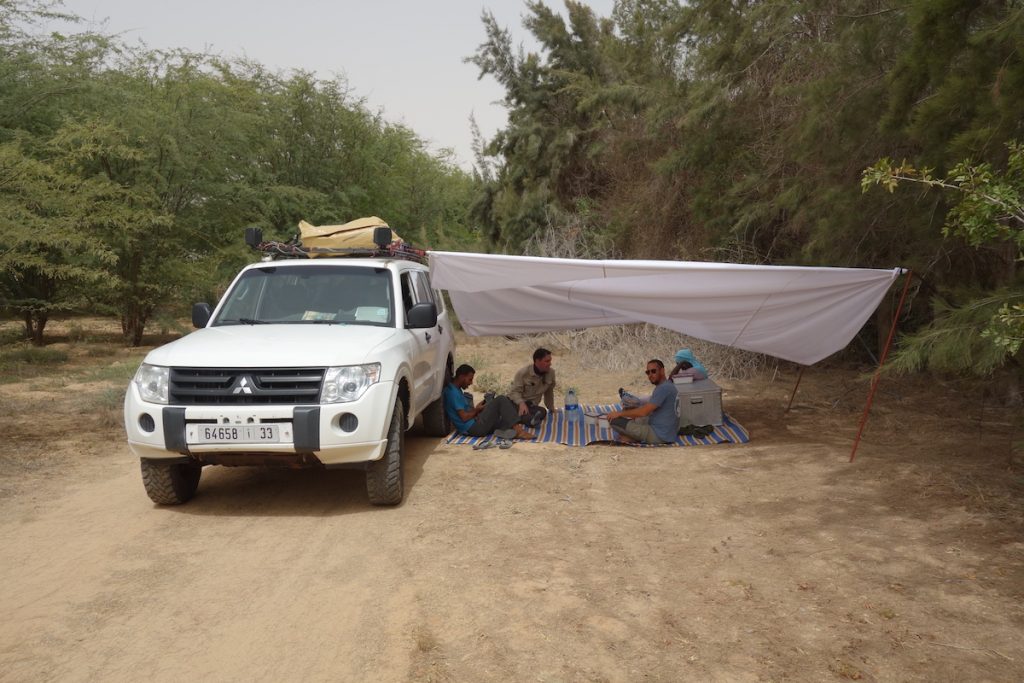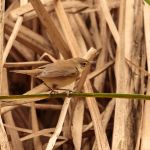Nico and his colleagues picked us up at 08.30 from outside our hotels and once we had packed our gear for our three days in the desert we set off. Before we left Dakhla we drove around a number of spots on the Atlantic and bay side of the peninsular where he regularly encountered Royal Terns with zero success. Wishing to see Royal Tern before we headed out to Assouerd we took a short detour South to a site on the East side of the bay where terns are known to gather. It was a lovely spot and there were certainly good numbers of Spoonbills, Caspian Terns and waders, but none of the hoped for Royals and after half an hour we pressed on.
Our next stop was a private farm (Mijk) that Dakhla Rovers have permission to visit with their clients – the principle business is growing tomatoes and melons in huge polythene and canvas greenhouses. However, when the farm was established around a borehole the owner planted trees and constructed some pools which given the location in the middle of the Sahara makes for a very potent migrant trap. For example the second Great Bittern for the Western Sahara had been recorded here three days previously. As soon as we got out of the car it was apparent that the trees and bushes were alive with birds to the extent that it was hard to know where to start.

After walking around to get a feel for what was about we decided to sit quietly in the shade and allow the birds to come to us – Graham stationed himself in a small irrigated orchard and I elected for some reed fringed pools under the shade of the canopy. After an hour or so we broke for a picnic lunch under a makeshift awning and then opted to for different stations.
Mijk Farm Migrants – click on a thumbnail to enlarge
Mijk farm has pretty much everything a migration enthusiast and photographer could ask for and it was hard to drag ourselves away, but we needed to head East. Before we hit the Assouerd road proper we stopped briefly at Tachaktant, but found very little that had not been there the previous day apart from a rather showy Western Olivaceous Warbler.

Since the early visits by the Punkbirders in the mid-noughties the Assouerd Road has established itself as a Western Palearctic hotspot and the place to visit for a number of regionally scarce species – but before we got to look for the first of these; Dunn’s Lark we had to drive an hour or so along the tarmac road with the car thermometer reporting 35oC we stopped only once for a party of Cream Coloured Coursers.

Many years ago, I saw “Dunn’s Lark” in Israel, but with every likelihood that the Asian form will be split as a separate species, Arabian Lark, it was one I was keen to see. When we arrived at the coordinates we split up to search the tufts of long grass under which the larks shelter to get what shade they can in the unforgiving environment. After ten minutes or so Graham located a couple of birds and we settled down to photograph them which was easier said than done in the intense light and heat as it was 2 pm and the sand was so hot that it burnt our knees.


After re-hydrating and a brief rest we drove a few km further East to a site at which the Wise Birding group had seen African Desert Warbler a few days previously and only ca 800 m from the GPS coordinates where Martin Casemore had seen them a couple of weeks earlier. Given the uniformity of the dwarf scrub habitat we were clearly in the right area and did not expect too many problems – but after searching assiduously for the best part of an hour we had nothing to show for our efforts. After a further hour of driving we reached Oued Jenna which is a wide wadi full of large acacias that runs NW-SE across the road and the site for the golden duo; Nightjar and Sparrow. Given that it was now early evening and we wished to eat before going spotlighting for mammals we could only spend an hour in part of the NW section of the wadi close to the road, but that was long enough for us to find our first Fulvous Babblers and Cricket Longtails (WP #693).

A further 20 minutes drive East is Assouerd a settlement of 120 people that is also home to a brutal looking basic training camp for recruits to the Moroccan military, at least they get single tents, and a UN Mission (MINURSO) involved in an ongoing project to clear land mines. Dakhla Rovers have access to a large house in the town with hot and cold running water where clients can sleep on mattresses and eat breakfast and dinner which is a very positive alternative to rough camping in Oued Jenna. After a long day in the field we were more than happy to shower and rest for an hour or two before our evening session, although not before I was woken up by Desert Sparrow (WP #694) calling outside my bedroom window.
Our plan was to go out spotlighting for 2-3 hours getting back in sufficient time to grab 6 hrs sleep before trying for the nightjar which were reported to be singing only in the morning. After dinner we headed back West for an hour or so before slowly driving back home using the spotlights. On the way out we were lucky enough to encounter a Saharan Sand Viper crossing the road.

I had not spotlighted before – for those unfamiliar with this technique it involves shining a powerful light into the vegetation either site of the road in the hope of picking up the reflected light from the eyes (eyeshine) of a nocturnal animal. Nico’s 4X4 is well set up for this activity with two front mounted LED spots on the front of the car and two handheld spots to play on the vegetation at 90o to the moving vehicle. I was i/c of one of the hand-held spots and a touch anxious that I would stuff it up. I need not have been and after 20 mins my spot made contact with a stationary animal about 250 m off the road. Nico swung his spot around and confirmed and fixed the animal and the three of us set off with headlamps and a hand-held spot to investigate – as we got closer our lights became sufficient to dimly illuminate the beast and confirm its identity – SAND CAT! Prior to departure this and Golden Nightjar were my two most wanted species from this trip – suppressing my excitement, I dialled the flash gun to max and hoped that the extender was enough to reach the cat – not quite so we edged closer and I had another go and got very lucky.

There are certainly better photos of Sand Cat than this, but I will always have a strong personal affinity with this Sand Cat which I spotlighted and photographed under a starry Saharan sky in a truly memorable encounter. Everything after that was a bit of an anti-climax and our spotlighting efforts lacked its earlier intensity. After a further 20 minutes, and a couple of stops for some roadside geckos, we called it a night and headed back to the house where a Ringed Wall Gecko under the security light bid us goodnight and brought our nocturnal adventure to an end.










